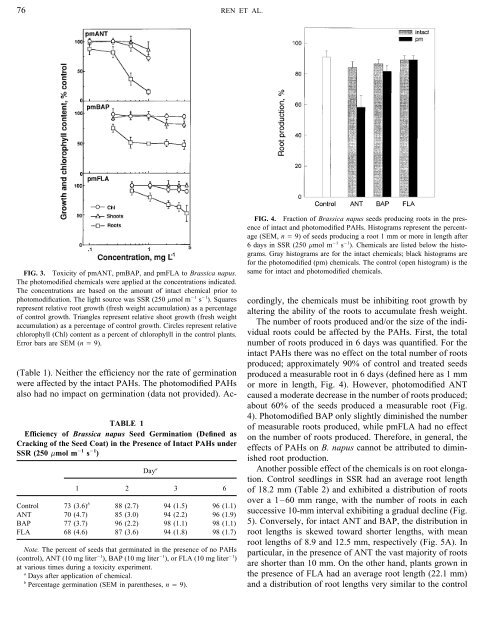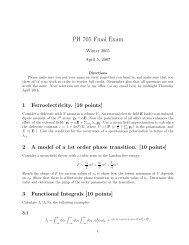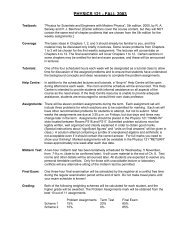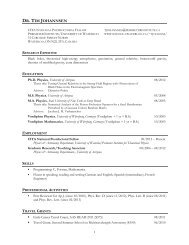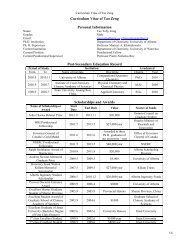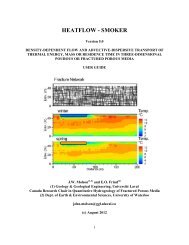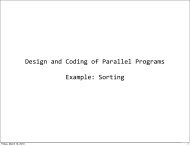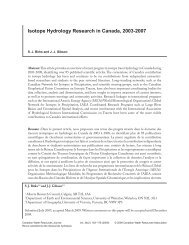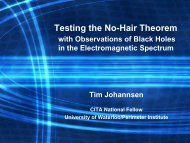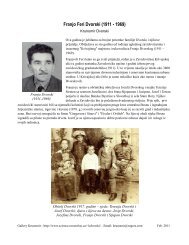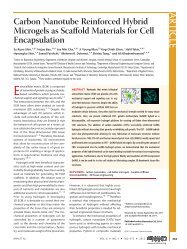45. Ren, L., Zeiler, L.F., Dixon, D.G. and Greenberg, B.M. 1996 ...
45. Ren, L., Zeiler, L.F., Dixon, D.G. and Greenberg, B.M. 1996 ...
45. Ren, L., Zeiler, L.F., Dixon, D.G. and Greenberg, B.M. 1996 ...
You also want an ePaper? Increase the reach of your titles
YUMPU automatically turns print PDFs into web optimized ePapers that Google loves.
76 REN ET AL.<br />
cordingly, the chemicals must be inhibiting root growth by<br />
altering the ability of the roots to accumulate fresh weight.<br />
The number of roots produced <strong>and</strong>/or the size of the indi-<br />
vidual roots could be affected by the PAHs. First, the total<br />
number of roots produced in 6 days was quantified. For the<br />
intact PAHs there was no effect on the total number of roots<br />
produced; approximately 90% of control <strong>and</strong> treated seeds<br />
produced a measurable root in 6 days (defined here as 1 mm<br />
or more in length, Fig. 4). However, photomodified ANT<br />
caused a moderate decrease in the number of roots produced;<br />
about 60% of the seeds produced a measurable root (Fig.<br />
4). Photomodified BAP only slightly diminished the number<br />
of measurable roots produced, while pmFLA had no effect<br />
on the number of roots produced. Therefore, in general, the<br />
effects of PAHs on B. napus cannot be attributed to diminished<br />
root production.<br />
Day a<br />
Another possible effect of the chemicals is on root elongation.<br />
Control seedlings in SSR had an average root length<br />
1 2 3 6 of 18.2 mm (Table 2) <strong>and</strong> exhibited a distribution of roots<br />
over a 1–60 mm range, with the number of roots in each<br />
FIG. 3. Toxicity of pmANT, pmBAP, <strong>and</strong> pmFLA to Brassica napus.<br />
The photomodified chemicals were applied at the concentrations indicated.<br />
The concentrations are based on the amount of intact chemical prior to<br />
photomodification. The light source was SSR (250 mmol m 01 s 01 ). Squares<br />
represent relative root growth (fresh weight accumulation) as a percentage<br />
of control growth. Triangles represent relative shoot growth (fresh weight<br />
accumulation) as a percentage of control growth. Circles represent relative<br />
chlorophyll (Chl) content as a percent of chlorophyll in the control plants.<br />
Error bars are SEM (n Å 9).<br />
(Table 1). Neither the efficiency nor the rate of germination<br />
were affected by the intact PAHs. The photomodified PAHs<br />
also had no impact on germination (data not provided). Ac-<br />
TABLE 1<br />
Efficiency of Brassica napus Seed Germination (Defined as<br />
Cracking of the Seed Coat) in the Presence of Intact PAHs under<br />
SSR (250 mmol m 01 s 01 )<br />
FIG. 4. Fraction of Brassica napus seeds producing roots in the presence<br />
of intact <strong>and</strong> photomodified PAHs. Histograms represent the percentage<br />
(SEM, n Å 9) of seeds producing a root 1 mm or more in length after<br />
6 days in SSR (250 mmol m 01 s 01 ). Chemicals are listed below the histograms.<br />
Gray histograms are for the intact chemicals; black histograms are<br />
for the photomodified (pm) chemicals. The control (open histogram) is the<br />
same for intact <strong>and</strong> photomodified chemicals.<br />
Control 73 (3.6) b 88 (2.7) 94 (1.5) 96 (1.1)<br />
ANT 70 (4.7) 85 (3.0) 94 (2.2) 96 (1.9) successive 10-mm interval exhibiting a gradual decline (Fig.<br />
BAP 77 (3.7) 96 (2.2) 98 (1.1) 98 (1.1) 5). Conversely, for intact ANT <strong>and</strong> BAP, the distribution in<br />
FLA 68 (4.6) 87 (3.6) 94 (1.8) 98 (1.7) root lengths is skewed toward shorter lengths, with mean<br />
root lengths of 8.9 <strong>and</strong> 12.5 mm, respectively (Fig. 5A). In<br />
Note. The percent of seeds that germinated in the presence of no PAHs particular, in the presence of ANT the vast majority of roots<br />
(control), ANT (10 mg liter 01 ), BAP (10 mg liter 01 ), or FLA (10 mg liter 01 )<br />
at various times during a toxicity experiment.<br />
are shorter than 10 mm. On the other h<strong>and</strong>, plants grown in<br />
a<br />
Days after application of chemical.<br />
the presence of FLA had an average root length (22.1 mm)<br />
b<br />
Percentage germination (SEM in parentheses, n Å 9).<br />
<strong>and</strong> a distribution of root lengths very similar to the control


